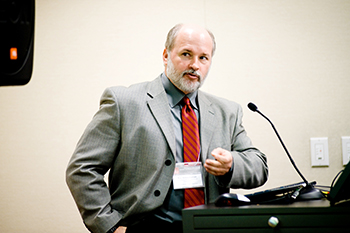
Roy Schwartzman
Professor Roy Schwartzman is proof that you don’t need to be a historian to make full use of the Visual History Archive in teaching and research.
Schwartzman, a communication professor at University if North Carolina, Greensboro, not only utilizes testimony today but was the first to propose making UNCG a full Visual History Archive access site in 2009. Since then, he has been a USC Shoah Foundation Teaching Fellow and has presented at USC Shoah Foundation’s international conferences in 2010 and 2014.
Schwartzman was first introduced to the Visual History Archive after participating in a grant writing workshop in 2007, in which he proposed a research project about Holocaust witness testimony. One of the workshop presenters was Christopher Browning, a Holocaust scholar at UNC Chapel Hill, who suggested Schwartzman explore the testimonies in USC Shoah Foundation’s Visual History Archive.
The archive was so engaging, Schwartzman said, and he was spending so much time commuting from Greensboro to Chapel Hill, which was a full access site, that he wanted Greensboro to have full access as well. A portion of the royalties from the communication textbook he wrote now goes toward funding the subscription fee.
Once Greensboro’s access was set up, Schwartzman quickly began bringing testimony into his communication courses. During his teaching fellowship at USC Shoah Foundation in 2012, he developed an honors communication course called “Witnessing the Holocaust,” and he also teaches a more advanced course that looks at different dimensions of the Holocaust through the lens of communication.
When they work with testimony, Schwartzman said students take much greater ownership of the material than they would if they were simply using standard primary source documents, because they feel a personal connection to the survivors.
“Very quickly when students start formulating ideas for projects utilizing the testimonies, they’ll start talking about “my” survivor,” Schwartzman said. “I almost never hear that when a student is describing a conventional research project based on standard library resources.”
Students of all backgrounds and majors are able to find testimonies relevant to their interests – from music majors who are fascinated to hear survivors talk about how music affected them during genocide to women’s studies majors who find testimonies of female survivors describing sexual abuse experiences.
“It’s so exciting for them to see their area of study having a personal significance for others,” Schwartzman said.
He is currently using the Visual History Archive in several research projects of his own: Nazi sterilization in comparison to the North Carolina sterilization program of the 20th century, anti-Semitism as a form of risk communication, how Jews responded to anti-Semitic childhood bullying, and identity formation in Holocaust survivor immigrants to the United States, which will be published in the upcoming issue of the Journal of Social Issues.
As a researcher, the Visual History Archive offers more than Schwartzman would get from simply studying books or other archival documents. Each testimony offers multiple perspectives and real “lived experiences,” he said. Most thrilling of all is the fact that he is always learning something new from the testimonies, even after working with them for years.
He hopes the Visual History Archive’s presence at UNCG continues to grow as more faculty learn how to use it and find testimonies that are relevant to their subject areas. Though some departments may not think of it as being applicable to them, Schwartzman himself is a perfect example of how a non-historian – in communication, psychology, sociology, or most other fields – can use testimony in a variety of meaningful ways.
“I’d like to see this be a well that all the different disciplines can draw from to enrich their studies,” he said.